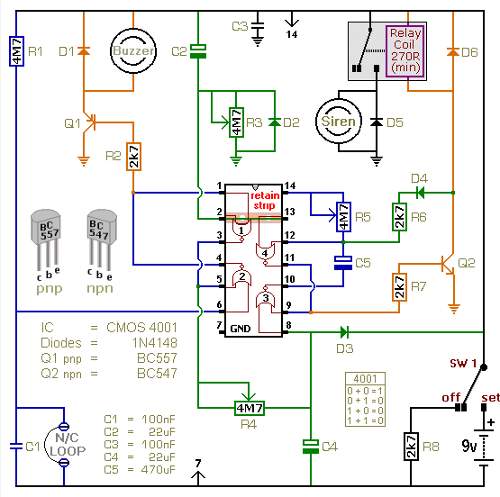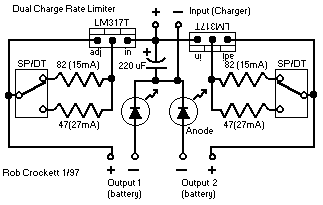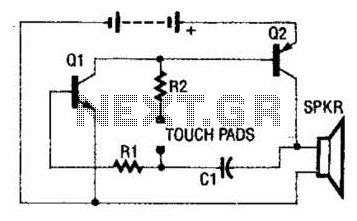
Battery Powered Burglar Alarm Sensor Circuit

The following circuit illustrates a battery-powered burglar alarm sensor circuit. Features include foil tape and passive infrared sensors (PIRs), as well as magnetic reed contacts.
This battery-powered burglar alarm sensor circuit is designed to provide an effective security solution for residential and commercial properties. The primary components of the circuit include a passive infrared sensor (PIR), which detects motion by sensing changes in infrared radiation emitted by objects within its range. Additionally, magnetic reed contacts are employed to monitor the opening and closing of doors or windows, enhancing the overall security system.
The circuit operates on a low-voltage battery, ensuring that it remains functional during power outages. The PIR sensor is typically mounted in a location that covers the entrance or area to be monitored, and it is configured to trigger an alarm when motion is detected. The alarm can be an audible sound, a visual indicator, or a notification sent to a mobile device, depending on the specific design and components used.
Foil tape serves as a simple and effective means to create a conductive path that can be used in conjunction with the magnetic reed contacts. When a door or window is opened, the magnetic field is disrupted, causing the circuit to activate the alarm. This dual-layered approach of using both PIR sensors and magnetic contacts ensures that the system is robust and capable of detecting unauthorized entry through various means.
The circuit design may also incorporate additional features such as a delay timer to prevent false alarms caused by pets or small animals, and an adjustable sensitivity setting for the PIR sensor to cater to different environmental conditions. Overall, this battery-powered burglar alarm sensor circuit offers a reliable and efficient method for enhancing security in various settings.The following circuit shows about Battery Powered Burglar Alarm Sensor Circuit. Features: foil tape and PIRs, such as magnetic-reed contacts, .. 🔗 External reference
This battery-powered burglar alarm sensor circuit is designed to provide an effective security solution for residential and commercial properties. The primary components of the circuit include a passive infrared sensor (PIR), which detects motion by sensing changes in infrared radiation emitted by objects within its range. Additionally, magnetic reed contacts are employed to monitor the opening and closing of doors or windows, enhancing the overall security system.
The circuit operates on a low-voltage battery, ensuring that it remains functional during power outages. The PIR sensor is typically mounted in a location that covers the entrance or area to be monitored, and it is configured to trigger an alarm when motion is detected. The alarm can be an audible sound, a visual indicator, or a notification sent to a mobile device, depending on the specific design and components used.
Foil tape serves as a simple and effective means to create a conductive path that can be used in conjunction with the magnetic reed contacts. When a door or window is opened, the magnetic field is disrupted, causing the circuit to activate the alarm. This dual-layered approach of using both PIR sensors and magnetic contacts ensures that the system is robust and capable of detecting unauthorized entry through various means.
The circuit design may also incorporate additional features such as a delay timer to prevent false alarms caused by pets or small animals, and an adjustable sensitivity setting for the PIR sensor to cater to different environmental conditions. Overall, this battery-powered burglar alarm sensor circuit offers a reliable and efficient method for enhancing security in various settings.The following circuit shows about Battery Powered Burglar Alarm Sensor Circuit. Features: foil tape and PIRs, such as magnetic-reed contacts, .. 🔗 External reference





